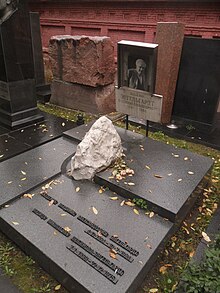Vladimir Alexandrowitsch Engelhardt
Wladimir Alexandrowitsch Engelhardt ( Russian Владимир Александрович Энгельгардт ; born November 21, 1894 in Moscow ; † July 10, 1984 ibid) was a Russian biochemist . He is considered the father of molecular biology in the Soviet Union .
Engelhardt was a member of the Baltic aristocratic Engelhardt family , grew up as the son of a country doctor in Yaroslavl and studied electrical engineering in Saint Petersburg , then mathematics at Lomonossow University , but switched to chemistry and then to medicine with a focus on biochemistry. After graduating in 1919 and two years of military service, he returned to Moscow University in 1921, where he became a professor. From 1929 he taught at the University of Kazan as head of the biochemistry department, then in Leningrad and finally again at the Lomonosov University. He was head of a laboratory at the Bach Institute for Biochemistry and the Pavlov Institute for Physiology , before becoming director of his own institute in 1957, the Institute for Radiation and Physical-Chemical Biology and later the Engelhardt Institute for Molecular Biology of the Russian Academy, which was named after him of the sciences that he directed until his death.
Engelhardt and his wife Militza Lyubimowa examined the myosin of the muscles in 1939 and found that it could split ATP and thus obtain energy for muscle contraction. For this work he received the Stalin Prize in 1943 .
He independently proposed the mechanism of the Pasteur effect . Later he dealt with vitamins , their biological function, but also their industrial production.
In 1967 he received the Cothenius Medal .
He had been a full member of the Soviet Academy of Sciences since 1953 , and in 1956 he was elected a member of the Leopoldina . In 1950 he became a corresponding member of the Academy of Sciences of the GDR and a foreign member in 1969 . In 1961 he was elected to the American Academy of Arts and Sciences , in 1973 to the National Academy of Sciences .
Web links
- Literature by and about Vladimir Alexandrowitsch Engelhardt in the catalog of the German National Library
- biography
- Photo at the Smithsonian
- Sergei Orlov: On the history of ecto-ATPase: The Role of WA Engelhardt , Purinergic Signaling, Jun 2007; 3 (3): 231–232 PMC 2096641 (free full text)
- Walter Sullivan: In search of a better world: Uprising of the heretics in: Der Spiegel October 30, 1967 (article on Soviet genetics according to Lysenko with mention of Engelhardt)
- Entry at the Berlin-Brandenburg Academy of Sciences
| personal data | |
|---|---|
| SURNAME | Engelhardt, Vladimir Alexandrowitsch |
| ALTERNATIVE NAMES | Энгельгардт, Владимир Александрович (Russian) |
| BRIEF DESCRIPTION | Russian biochemist |
| DATE OF BIRTH | November 21, 1894 |
| PLACE OF BIRTH | Moscow |
| DATE OF DEATH | July 10, 1984 |
| Place of death | Moscow |
